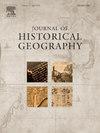动员土地:20世纪加尔各答和孟买的房地产和资本主义的空间过程
IF 1.1
2区 历史学
Q2 GEOGRAPHY
引用次数: 0
摘要
众所周知,资本主义制度下的土地很难分析。将其视为真实或虚构的资本/商品可能会导致忽视土地的理论和经济意义,而将其与资本/商品区分开来可能会不成比例地将焦点限制在土地抵抗金融化/商品化的情况下。那么,我们如何才能理解土地的物质位置,以及资本主义中为积累而循环土地的结构性要求?本文认为,应对资本主义中土地带来的挑战的有效方法是使用“土地动员”的分析。这不仅可以帮助我们解释土地转化为资产的难度和不完整性,还可以帮助我们考虑诸如金融化水平的差异和持有房地产的战略原因等因素,这些因素在房地产市场形成和资本主义历史地理的学术分析中经常被遗漏。为了证明这种方法的多产性,本文考察并比较了殖民后期和后殖民早期加尔各答和孟买的商业和土地精英如何理解房地产市场,如何采取行动,以及它的后果。通过这种比较,本文表明,在资本主义历史地理的形成过程中,动员土地的局部斗争一直是中心。本文章由计算机程序翻译,如有差异,请以英文原文为准。
(Im)mobilizing land: Real property and Capitalism's spatial processes in twentieth-century Calcutta and Bombay
Land in capitalism is notoriously difficult to analyse. Treating it as real or fictitious capital/commodity can lead to a neglect of land's theoretical and economic significance, while treating it as distinct from capital/commodity can disproportionately limit focus to cases where land resists financialization/commodification. How, then, can we make sense of land's material placeness alongside the structural requirement to circulate it for accumulation in capitalism? This article argues that a productive way to wrestle with the challenge posed by land in capitalism is to use the analytic of ‘land mobilization.’ This can not only help us account for the difficulty and incompleteness of land's transformation into an asset, but it can also help to include factors such as differences in levels of financialization and strategic reasons for holding real-property that are often left out of scholarly analyses in the making of real estate markets and the historical geographies of capitalism. To demonstrate the fecundity of this approach, this article examines and compares how business and landed elites in late colonial and early postcolonial Calcutta and Bombay understood the real property market, acted on it, and its consequences. Through this comparison, this article suggests that localized struggles to (im)mobilize land have been central in the making of capitalism's historical geographies.
求助全文
通过发布文献求助,成功后即可免费获取论文全文。
去求助
来源期刊

Journal of Historical Geography
Multiple-
CiteScore
1.50
自引率
10.00%
发文量
53
期刊介绍:
A well-established international quarterly, the Journal of Historical Geography publishes articles on all aspects of historical geography and cognate fields, including environmental history. As well as publishing original research papers of interest to a wide international and interdisciplinary readership, the journal encourages lively discussion of methodological and conceptual issues and debates over new challenges facing researchers in the field. Each issue includes a substantial book review section.
 求助内容:
求助内容: 应助结果提醒方式:
应助结果提醒方式:


